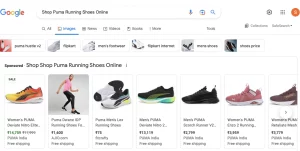Display Ads Vs Search Ads: What’s the best for you?
Online ads such as search and display ads are essential for businesses to reach a wider audience, increase brand visibility, and drive traffic to their websites or social media platforms. They also allow companies to target specific demographics and track their advertising results.

With the increase in internet usage and online shopping, online ads are becoming more important than ever for businesses to stay competitive and grow their customer base.
Let us dive deep into online advertisement and which ad type is best for you?
Stats on Online Advertising
- India’s online ad spending to reach $9.9 billion in 2021
- Google and Facebook dominate market with 80% share
- Mobile ads most popular, accounting for 78% of spending
- Display ad CTR lower than global average at 0.13%
- Video ads gaining popularity, with expected growth rate of 21%
What are Display Ads?
- Display ads are visual ads that appear on websites, apps, or social media platforms.
- They are designed to capture the user’s attention and promote a product, service, or brand.
- They can target specific audiences based on demographics, interests, and behaviour.
- They can also be retargeted to users who have previously interacted with a website or product.
- These ads are often sold on a cost-per-impression (CPM) or cost-per-click (CPC) basis.
- It is an effective way for businesses to increase brand awareness and drive traffic to their website or product.
- Example of a Display Ad

Source: www.google.com
Flipkart, an Indian e-commerce company, uses these ads on websites, apps, and social media to promote its products and services to a broader audience. For example, Flipkart may show banner ads for a specific product or offer, such as discounts on electronics or fashion. These ads may target users who have shown interest in similar products or have previously visited Flipkart’s website or app. Overall, Flipkart’s display ads help the company increase brand awareness, drive traffic to its website, and boost sales and revenue.
Read: Beginner’s Guide to Performance Marketing
What are Search Ads?
Search ads are text-based ads that appear at the top or bottom of search engine results pages when people search for keywords related to your products or services.
Search ads target specific keywords that people are actively searching for. When someone types a relevant keyword into a search engine like Google, search ads are displayed alongside the organic search results.
You can pay for search ads on a cost-per-click (CPC) basis, meaning you only pay when someone clicks on your ad. You can set bids for specific keywords, and the search engine will use an auction system to determine which ads to display.
Search ads are an effective way to reach potential customers who are already interested in what you have to offer.
Example of Search Ads
Suppose a user searches for “buy running shoes online” on Google. One possible search ad that could appear is from the Indian sportswear brand Puma. The ad might include a headline like “Shop Puma Running Shoes Online,” a description of the products or sale offer, and a call-to-action button like “Shop Now” or “Buy Online.”

Source: www.google.com
The ad would be targeted to users who are searching for running shoes and related keywords. If the user clicks on the ad, they will be directed to Puma’s website to browse and purchase running shoes. Using search ads, Puma can reach a highly targeted audience and drive traffic to their website, ultimately increasing sales and revenue.
Search Ads Vs Display Ads
The table contains the difference between the search ads and the display ads:
| Particulars | Search Ads | Display Ads |
| Definition | Text-based ads that appear at the top or bottom of the search engine results per page (SERP) | Image, video, or banner ads that appear on websites, apps or social media platforms |
| Targeting | Based on specific keywords or phrases that users are searching for | Based on user demographics, interests and behaviour |
| Placement | Search Ads appear on search engine results pages | Appears on websites, apps, or social media platforms |
| Cost Model | Cost-Per-Click (CPC) | Cost-per-Impression (CPM) or Cost-per-Click (CPC) |
| Ad Format | Text-based within limited characters | Image, video, or banner ads with more creative freedom |
| Purpose | Direct Response and conversion oriented | Brand awareness and reach oriented |
Benefits Of Search Advertising Over Display Advertising
Here are some benefits of search advertising over display advertising in bullet points:
- Search ads are more targeted and have higher intent than display ads.
- Search ads are shown to users actively searching for a particular product or service, while display ads can be delivered to users not actively searching.
- Search ads can be targeted to specific keywords or phrases, allowing advertisers to reach users interested in their product or service.
Search ads are typically more cost-effective than display ads.
- Search ads are sold on a cost-per-click (CPC) basis, meaning advertisers only pay when users click on their ad.
- Display ads are often sold on a cost-per-impression (CPM) basis, meaning that advertisers pay for every time their ad is displayed, even if a user does not click on it.
Search ads have a higher likelihood of conversion or action than display ads.
- Search ads are shown to users who are already interested in a particular product or service, making them more likely to convert into customers.
- Display ads can be shown to users who are not interested in the product or service being advertised, so they are less likely to convert into customers.
Benefits Of Display Advertising Over Search Advertising
Some benefits of display advertising over search advertising:
- Brand Awareness: Display ads can help increase brand awareness by reaching a wider audience and exposing them to the brand’s message, products or services.
- Creative Freedom: Display ads offer more creative freedom than search ads, allowing advertisers to use images, videos, and interactive elements to capture the audience’s attention.
- Reach: Display ads can reach a larger audience than search ads, as they are displayed on various websites, social media platforms, and mobile apps, increasing the chances of reaching potential customers.
- Visual Appeal: Display ads are more visually appealing than text-based search ads, using images, videos, and animations to grab users’ attention.
- Targeting: Display ads can be targeted to specific demographics, interests, and behaviors, such as people who have visited a certain website or watched a certain video. This allows advertisers to reach a more relevant audience, increasing the chances of conversions.
- Retargeting: Display ads can be used for retargeting, which means showing ads to people who have already interacted with a brand’s website or products. This can be a very effective way to convert people who have already shown interest in what you have to offer.
Conclusion
Search ads and display ads have their own advantages and disadvantages. Looking for fixing the company revenues by advertising online on websites, contact us.
Which ad goes more effective for your website we will find out depending on the requirement.
Search ads are more effective for direct response and driving conversions as they are shown to users actively searching for a particular product or service. They offer more precise targeting and a cost-effective pricing model based on cost-per-click.
Display ads are better for building brand awareness, reaching a wider audience, and showing visually appealing ads. They offer more creative freedom, targeting options, and the ability to retarget users interacting with the brand’s website or products.
Search ads, on the other hand, are better for generating leads and sales.
The best approach for businesses is to use search and display ads to create a comprehensive advertising strategy covering both direct response and brand building.
By understanding the unique benefits of each type of ad, businesses can create a balanced advertising mix that helps them achieve their marketing goals and reach their target audience effectively.
FAQ
What are display ads?
Display ads are visual online ads that appear on websites, social media platforms, and mobile apps. They use images, videos, and other interactive elements to grab the audience’s attention.
What are search ads?
Search ads are text ads at the top or bottom of search engine results pages (SERPs) when people search for specific keywords or phrases.
Which type of ad is more effective: display ads or search ads?
How effective an ad is depends on what the business wants to achieve. For example, search ads are better for generating leads and sales, while display ads are better for building brand awareness and reaching a wider audience.
How do display ads and search ads differ in terms of targeting?
Search ads can be targeted precisely based on the specific keywords or phrases people search for, while display ads can be targeted based on people’s demographics, interests, and behaviours.
Which type of ad is more cost-effective: display ads or search ads?
Search ads are usually more cost-effective because they are priced on a cost-per-click (CPC) basis, which means that advertisers only pay when someone clicks on their ad. Display ads, on the other hand, can be priced on a cost-per-impression (CPM) or CPC basis, depending on the ad platform and targeting options.
Can search ads and display ads be used together?
Yes, businesses can use search and display ads to create a comprehensive advertising strategy covering both direct response and brand building. By understanding the unique benefits of each type of ad, businesses can create a balanced advertising mix that helps them achieve their marketing goals and reach their target audience effectively.



